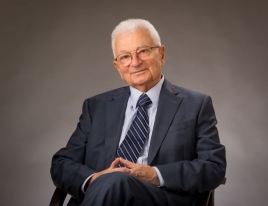Yuri Oganessian
Thursday, May 15, 2025
He succeeded Georgy Flyorov as director of the Flyorov Laboratory of Nuclear Reactions at the Joint Institute for Nuclear Research in 1989 and is now its scientific director.[10] The heaviest element known of the periodic table, oganesson, is named after him, only the second time that an element was named after a living person (the other being seaborgium).
Yuri Tsolakovich Oganessian was born in Rostov-on-Don, Russian SFSR, USSR on 14 April 1933 to Armenian parents. His father was from Igdir (now in Turkey), while his mother was from Armavir in what is now Russia's Krasnodar Krai. Oganessian spent his childhood in Yerevan, the capital of Soviet Armenia, where his family relocated in 1939. His father, Tsolak, a thermal engineer, was invited to work on the synthetic rubber plant in Yerevan. After the Eastern Front of World War II commenced, his family decided not to return to Rostov since it was occupied by the Germans. Yuri attended and finished school in Yerevan.He initially wanted to become a painter.
Oganessian was married to Irina Levonovna (1932–2010), a violinist and a music teacher in Dubna, with whom he had two daughters. As of 2017, his daughters resided in the U.S.
Oganessian speaks Russian, Armenian,[15] and English.
Oganessian graduated from the Moscow Engineering Physics Institute (MEPhI) in 1956.[9][12] He thereafter sought to join the Kurchatov Institute of Atomic Energy in Moscow, but as there were no vacancies left in Gersh Budker's team, he was instead recruited by Georgy Flyorov and began working at the Joint Institute for Nuclear Research (JINR) in Dubna, near Moscow.[7][12]
He became director of the Flyorov Laboratory of Nuclear Reactions at JINR in 1989, after Flyorov retired, and had the job until 1996, when he was named the scientific director of the Flyorov laboratory.[10]
Discovery of superheavy chemical elements
[edit]During the 1970s, Oganessian invented the "cold fusion" method, a technique to produce transactinide elements (superheavy elements). Though they share a name this process is unrelated to the unproven energy-producing process also named cold fusion. Oganessian's process was crucial for the discoveries of elements from 106 to 113.From the mid-1970s to the mid-1990s, the partnership of JINR, directed by Oganessian, and the GSI Helmholtz Centre for Heavy Ion Research in Germany, resulted in the discovery of six chemical elements (107 to 112): bohrium, meitnerium, hassium,darmstadtium, roentgenium, and copernicium.
His newer technique, termed "hot fusion" (also unrelated to nuclear fusion as an energy process), helped lead to the discovery of elements 113 to 118, completing the seventh row of the periodic table. The technique involved bombarding calcium into targets containing heavier radioactive elements that are rich in neutrons at a cyclotron.The elements discovered using this method are nihonium (2003; also discovered by Riken in Japan using cold fusion), flerovium (1999), moscovium (2003), livermorium (2000), tennessine (2009), and oganesson (2002).





